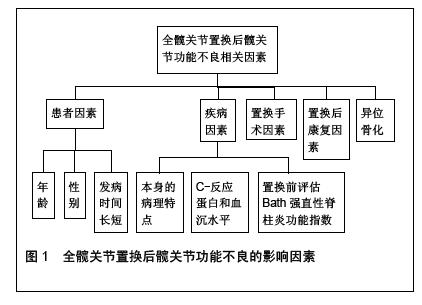[1] 游浩,程翠年,张卉,等.强直性脊柱炎病因及其发病机制的研究进展[J].中国中医骨伤科杂志,2012,20(9):77-79.
[2] 张亮,徐辉,郭晓忠,等.人工全髋关节置换术治疗强直性脊柱炎的中期疗效[J].中国修复重建外科杂志,2014,28(1):1-6.
[3] Hardinge K,Williams D,Etienne A, et al. Conversion of fused hips to low friction arthroplasty. J Bone Joint Surg Br. 1977; 59-B(4): 385-392.
[4] Vander Cruyssen B,Muñoz-Gomariz E,Font P, et al. Hip involvement in ankylosing spondylitis: epidemiology and risk factors associated with hip replacement surgery. Rheumatology (Oxford). 2010;49(1):73-81.
[5] Chen HA, Chen CH, Liao HT, et al. Factors associated with radiographic spinal involvement and hip involvement in ankylosing spondylitis. Semin Arthritis Rheum. 2011;40(6): 552-558.
[6] Silbersack Y, Taute BML, Hein W, et al. Prevention of deep-vein thrombosis after total hip and knee replacement. Low-molecular-weight heparin in combination with intermittent pneumatic compression. J Bone Joint Surg Br. 2004;86(6): 809-812.
[7] Sochart DH, Porter ML. Long-term results of total hip replacement in young patients who had ankylosing spondylitis. Eighteen to thirty-year results with survivorship analysis. J Bone Joint Surg Am. 1997;79(8):1181-1189.
[8] Joshi AB, Markovic L, Hardinge K, et al. Total hip arthroplasty in ankylosing spondylitis: an analysis of 181 hips. J Arthroplasty. 2002;17(4):427-433.
[9] 李大河,徐卫东.全髋关节置换术治疗强直性脊柱炎的临床问题及研究进展[J].中华关节外科杂志(电子版) ,2012,6(4): 605-611.
[10] Holtzman J, Saleh K, Kane R. Effect of baseline functional status and pain on outcomes of total hip arthroplasty. J Bone Joint Surg. 2002;84-A:1942-1948.
[11] Peters MJ, van der Horst-Bruinsma IE, Dijkmans BA, et al. Cardiovascular risk profile of patients with spondylarthropathies, particularly ankylosing spondylitis and psoriatic arthritis. Semin Arthritis Rheum. 2004;34:585-592.
[12] Guan MQ, Wang J, Zhao L, et al. Management of hip involvement in ankylosing spondylitis. Clin Rheumatol. 2013; 32:1115-1120.
[13] Neumann L, Freund KG, Sorensen KH. Total hip arthroplasty with the Charnley prosthesis in patients fifty-five years old and less. Fifteen to twenty-one-year results. J Bone Joint Surg (Am). 1996;78:73-79.
[14] Ye C, Liu R, Sun C, et al. Cementless bilateral synchronous total hip arthroplasty in ankylosing spondylitis with hip ankylosis. Int Orthop. 2014;38(12):2473-2476.
[15] Mancuso CA, Sculco TP, Salvati EA. Patients with Poor Preoperative Functional Status Have High Expectations of Total Hip Arthroplasty. J Arthroplasty. 2003;18(7): 872-878.
[16] 陈铿,唐勇,黄霖,等.非骨水泥型全髋关节置换术治疗强直性脊柱炎髋关节病变的疗效分析[J].中华关节外科杂志(电子版),2009, 3(1):101-104.
[17] 白人晓,毕晓阳,张福江,等.关节成形术治疗强直性脊柱炎晚期严重髋关节畸形[J].中华骨科杂志,1999,19(7):400-403.
[18] Zhang L, Yang D, Yin X, et al.Risk factors for poor hip flexion after total hip arthroplasty for the treatment of ankylosing spondylitis a multivariate analysis. Clin Rheumatol. 2014; 33(9):1295-1301.
[19] Boonen A, Cruyssen BV, de Vlam K, et al. Spinal radiographic changes in ankylosing spondylitis:association with clinical characteristics and functional outcome. J Rheumatol. 2009; 36(6):1249–1255.
[20] Baraliakos X, Listing J, Brandt J, et al.Radiographic progression in patients with ankylosing spondylitis after 4 yrs of treatment with the anti-TNF-alpha antibody infliximab. Rheumatology (Oxford). 2007;46(9):1450-1453.
[21] O'Dwyer T,O'Shea F,Wilson F.Exercise therapy for spondyloarthritis: a systematic review.Rheumatol Int. 2014; 34(7):887-902.
[22] Li J, Xu W, Xu L, et al. Hip resurfacing arthroplasty for ankylosing spondylitis.J Arthroplasty. 2009;24(8):1285-1291.
[23] Baldursson H, Brattstrom H, Olsson T. Total hip replacement in ankylosing spondylitis. Acta Orthop Scand. 1977;48(5): 499-507.
[24] Finsterbush A, Amir D, Vatashki E, et al. Joint surgery in severe ankylosing spondylitis. Acta Orthop Scand. 1988; 59(5):491-496.
[25] Lacko M, Schreierová D, ?ellár R, et al. The incidence of osteopenia and osteoporosis in patients with cementless total hip arthroplasty. Acta Chir Orthop Traumatol Cech. 2015; 82(1): 61-66.
[26] Iwamoto N, Inaba Y, Kobayashi N, et al. The effectiveness of mono or combined osteoporosis drug therapy against bone mineral density loss around femoral implants after total hip arthroplasty. J Bone Miner Metab. 2014;32(5): 539-544.
[27] 常増林,李锋.嵌压植骨在强直性脊柱炎全髋关节置换术治疗中的应用[J].中国矫形外科杂志,2008,16(8): 631-633.
[28] 李锋,李光辉,杜杏利,等.强直性脊柱炎晚期严重髋关节畸形的手术治疗及康复[J].中华物理医学与康复杂志,2002,24(11): 653-655.
[29] Di Monaco M, Vallero F, Tappero R, et al. Rehabilitation after total hip arthroplasty: a systematic review of controlled trials on physical exercise programs.Eur J Phys Rehabil Med. 2009; 45(3):303-317.
[30] Jan MH, Hung JY, Lin JC, et al. Effects of a home program on strength, walking speed, and function after total hip replacement.Arch Phys Med Rehabil.2004;85(12):1943-1951.
[31] Trudelle-jackson E, Smith SS.Effects of a late-phase exercise program after total hip arthroplasty: a randomized controlled trial.Arch Phys Med Rehabil. 2004;85(7): 1056-1062.
[32] Unlu E, Eksioglu E, Aydog E, et al. The effect of exercise on hip muscle strength, gait speed and cadence in patients with total hip arthroplasty: a randomized controlled study. Clin Rehabil. 2007;21(8):706-711.
[33] Young AC, Buvanendran A. Pain management for total hip arthroplasty. J Surg Orthop Adv. 2014;23(1): 13-21.
[34] Bhan S, Eachempati KK, Malhotra R. Primary cementless total hip arthroplasty for bony ankylosis in patients with ankylosing spondylitis. J Arthroplasty. 2008;23(6):859-866.
[35] 陈余庆,季祝永,孙凤翔,等.全髋关节置换治疗强直性脊柱炎11例[J]. 中国组织工程研究与临床康复,2008,12(48):9553-9556.
[36] Tippets DM, Zaryanov AV, Burke WV, et al. Incidence of heterotopic ossification in direct anterior total hip arthroplasty: a retrospective radiographic review. J Arthroplasty. 2014; 29(9): 1835-1838.
[37] Beckmann JT, Wylie JD, Potter MQ, et al. Effect of Naproxen Prophylaxis on Heterotopic Ossification Following Hip Arthroscopy: A Double-Blind Randomized Placebo-Controlled Trial. J Bone Joint Surg Am. 2015;97(24): 2032-2037.
[38] Edwards DS, Clasper JC. Heterotopic ossification: a systematic review. J R Army Med Corps. 2015;161(4): 315-321.
[39] D'Lima DD, Venn-Watson EJ, Tripuraneni P, et al. Indomethacin versus radiation therapy for heterotopic ossification after hip arthroplasty. Orthopedics. 2001;24(12): 1139-1143.
[40] Weng HK, Wu PK, Chen CF, et al. Total Hip Arthroplasty for Patients Who Have Ankylosing Spondylitis: Is Postoperative Irradiation Required for Prophylaxis of Heterotopic Ossification? J Arthroplasty. 2015;30(10): 1752-1756.
.jpg)
